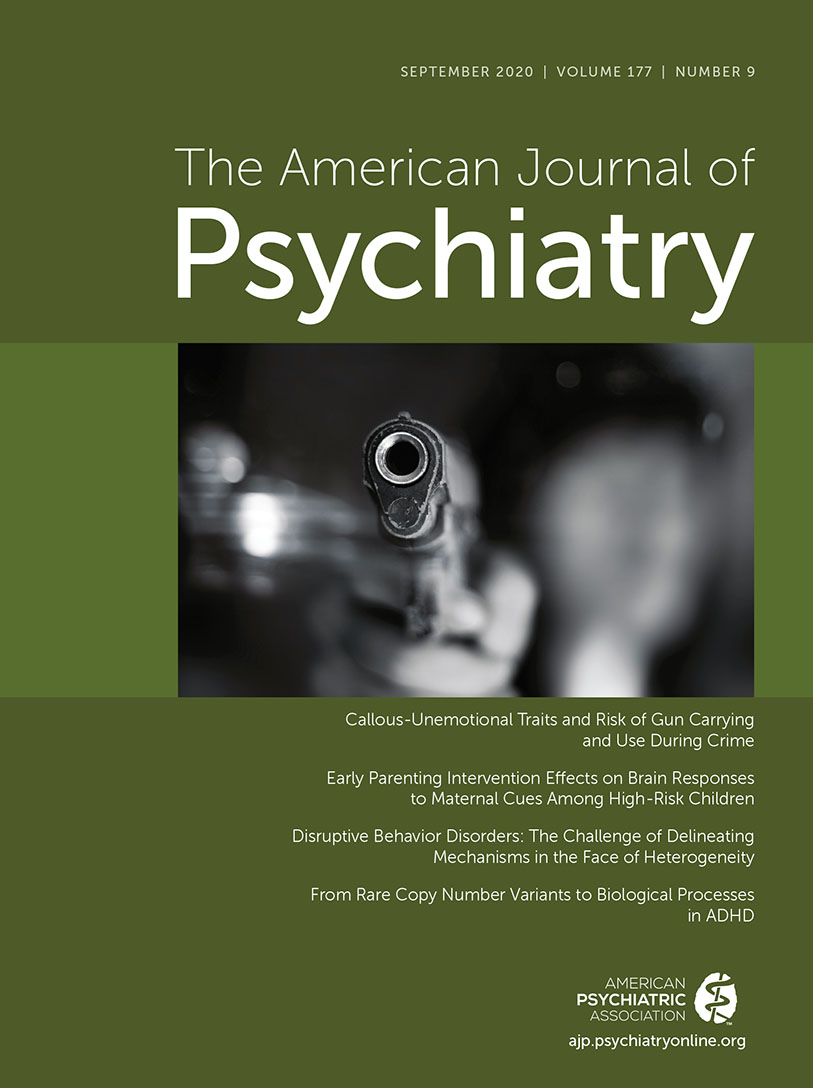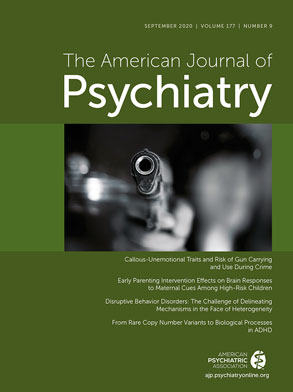Although attention deficit hyperactivity disorder (ADHD), autism spectrum disorder (ASD), and obsessive-compulsive disorder (OCD) are each characterized by their own core symptoms, these disorders frequently co-occur, and there is substantial phenomenological and pathophysiological overlap between them (
1). There is also evidence that they share etiological factors, including a partly overlapping genetic liability (
2). In addition, while ASD and ADHD by definition emerge in childhood, the majority of OCD cases have an onset either in childhood or in adolescence (
3). In an important study published in this issue of the
Journal, Boedhoe et al. (
4) propose that there are shared deficits in inhibitory control across these disorders, leading to impulsivity (in ADHD) and compulsive behaviors (in OCD and ASD). These similarities between the disorders in terms of neurocognitive vulnerabilities, symptoms, and etiological influences led Boedhoe and colleagues to ask whether common structural alterations in overlapping brain circuits confer risk for all three disorders. For example, are they all linked to impairments in the cortico-striato-thalamo-cortical and fronto-parietal networks implicated in impulsivity and compulsivity? In addition, are there developmental differences between the disorders—for example, greater stability in the structural alterations associated with some disorders compared with others, given that ASD is typically conceptualized as a lifelong condition, whereas 50%−60% of children with ADHD outgrow the disorder (
5,
6), and OCD is viewed as an illness that most individuals outgrow and is generally treatable (
7)?
To address these issues, the authors capitalized on the power of the Enhancing Neuroimaging Genetics Through Meta-Analysis (ENIGMA) consortium (
http://enigma.ini.usc.edu/) by analyzing structural MRI data from a very large sample containing thousands of individuals with ADHD, ASD, or OCD, plus an extremely large number of typically developing control subjects. The aim of the study was to test for shared brain abnormalities across these three disorders, as well as to identify disorder-specific alterations unique to ADHD, ASD, or OCD. Importantly in the context of this issue, the authors distinguished between pediatric, adolescent, and adult samples to examine whether the structural alterations associated with each disorder were observed consistently across the lifespan. This decision was informed by previous ENIGMA findings showing that ADHD-related alterations in cortical structure or subcortical volumes are most pronounced in pediatric compared with adolescent and adult samples (
8).
Perhaps surprisingly, there was no robust evidence for shared alterations in brain structure across the three disorders, although there were indications of common reductions in subcortical volumes and cortical thickness in ADHD and ASD in childhood. There were no shared alterations across the three disorders in the adolescent sample, and a lower hippocampal volume in OCD and ASD in adulthood did not survive correction for multiple comparisons.
In terms of disorder-specific effects, the authors found that ADHD in childhood is associated with lower global brain and hippocampal volumes relative to OCD and ASD (and the typically developing control group). This association between ADHD and lower global brain volume persists into adolescence, but is no longer present in adulthood. In contrast, OCD is linked to greater striatal and lower limbic volumes (amygdala and hippocampus) in adulthood, but not in childhood or adolescence. There were no disorder-specific effects on cortical thickness or surface area in the pediatric sample, and just a single region (medial orbitofrontal cortex) showed surface area differences in the adolescent sample (OCD < ADHD, ASD). Finally, adults with ASD showed increased cortical thickness in several frontal regions relative to adults with ADHD or OCD, but there were no surface area differences in this age group.
On the face of it, the lack of shared alterations across these neurodevelopmental disorders is somewhat unexpected given previous meta-analytic findings showing common reductions in gray matter volume across adult psychiatric disorders (
9), and generally the effect sizes detected were small (Cohen’s d values around 0.2), even for disorder-specific changes in brain volume or cortical structure. The fact that ADHD-specific alterations were most pronounced in childhood and none of the disorders were linked to structural changes that were stable across development challenges the notion that these disorders are fundamentally “brain disorders,” at least insofar as this can be tested using structural imaging measures. One explanation of the findings is that there is substantial clinical and pathophysiological heterogeneity within each disorder—and comorbidity represents a further source of heterogeneity that may have diluted the strength of the associations. Alternatively, it is possible that heterogeneity is not a major issue and the differences between disorders (and between individuals with disorders and typically developing individuals) in brain structure are indeed subtle. Future work in this area could assess the impact of heterogeneity by investigating the effects of specific symptoms or symptom clusters. It would also be interesting to examine whether assessing combinations of morphological features in parallel improves our ability to classify individuals into those with and those without disorders (see reference
10 for a study of ASD adopting a similar approach). Of note, the authors try to explain why the relationship between these disorders and structural alterations changes from childhood to adulthood with recourse to developmental trajectories (e.g., accelerated cortical expansion in ASD in childhood and decelerated thinning in adulthood, giving rise to greater frontal cortical thickness in adulthood), but such interpretations need to be made cautiously and highlight the need for large-scale longitudinal studies that allow such hypotheses to be rigorously tested.
In addition to the very impressive sample size and harmonized analytical approach, the study provides a useful model for future cross-disorder analyses comparing disorders that are more challenging to distinguish clinically and etiologically, such as major depressive disorder and bipolar disorder. The mega-analytical strategy developed by the authors, which involved using linear mixed-effects models to account for site effects and test for differences between the respective control groups across sites and working groups, could be applied in future studies comparing different combinations of disorders. In addition, the enormous amount of work done by each ENIGMA working group means that the data are in a good condition to be shared and used in future collaborative research. Another strength of the study is the ability to explore disorder-related alterations in brain structure across the lifespan, as most individual research groups focus on either children or adults.
Potential limitations of the study include its cross-sectional design, which means we cannot tell whether the observed brain abnormalities preceded the emergence of clinical symptoms in a manner that is consistent with a causal relationship. The correspondence between the pediatric, adolescent, and adult samples included in the study is also unclear—one would expect that, because many individuals outgrow ADHD, the adult ADHD sample would comprise the most severe and persistent cases, and therefore the associated brain alterations should be most, rather than least, pronounced in this age group. There is also evidence that pediatric OCD differs from adult OCD in several important ways, which suggests some developmental discontinuity between these subtypes (
11). In short, are the authors really studying the same clinical population by contrasting the effects of these disorders in childhood, adolescence, or adulthood using a cross-sectional approach if childhood- and adult-onset or remitting and persistent forms of the disorder differ from each other? Another factor to mention is that disorder-related changes have to be understood in the context of overall brain development—for example, individuals with ADHD may show initial delays in brain development but subsequently “catch up” with their typically developing peers (e.g.,
12).
There were also marked sex differences between groups, with over 80% of the ASD sample being male and the OCD and control groups being approximately 50% and 60% male, respectively. This may complicate the interpretation of disorder-related differences, given that sex differences in brain structure are well established (i.e., males tend to have 10% larger brains than females, and some individual regions show even greater sex differences [
13]). It should be noted that sex was included as a covariate in the analysis. Another limitation is that the OCD group was substantially smaller than the ADHD and ASD groups in the child and adolescent age brackets, but larger than the other groups in the adult sample. This imbalance may have had an impact on the statistical power of the study and therefore on the authors’ ability to detect OCD-specific brain alterations in childhood or adolescence. There were also much higher levels of comorbidity in the OCD group, although this may reflect a more careful characterization of the OCD participants’ mental health than true differences in comorbidity, as comorbidity rates in the ADHD and ASD groups appear lower than expected (especially anxiety disorders in ASD [
14]).
Overall, these new findings challenge the idea that alterations in brain structure are stable over time in the neurodevelopmental conditions studied by Boedhoe and colleagues. Instead, ADHD-related structural deficits appear to be most pronounced in childhood, whereas ASD-related structural differences seem to be most evident in adulthood, and in both cases the effect sizes are small. Thus, although there is considerable overlap between these disorders in terms of symptoms, etiological influences, and neuropsychological deficits, and they co-occur at higher rates than would be expected by chance, it appears that they are not associated with common alterations in brain structure (and particularly abnormal basal ganglia development). This, of course, does not preclude the possibility that there are common functional deficits in cortico-striatal and fronto-parietal circuits across these disorders that could be identified using functional MRI methods. In addition, assessing whether there are shared abnormalities in brain development across these disorders using longitudinal designs may provide evidence of common alterations (e.g., delays in brain development) that are not detectable using a cross-sectional approach.

